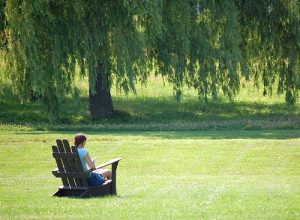Reading
3 Creating an Optimal Setting for Reading
Stop for a moment and think about yourself and the act of reading. Whether you read headlines or social media posts on a smartphone or tablet, love to settle in with the Sunday paper, devour stacks of hand-held magazines and hard copy books, or read only when forced to, what does reading look like for you?
- Consider your ideal spot for reading. Is it a favourite chair in your living room? Your bed? A coffee shop? The cool green grass in a local park?
- What’s your favourite time of day for reading?
- Do you read best in silence? Or do you like to have music playing, be around other people, or have some other sort of active distraction?
- Do you prefer print (hard copy) books, e-books, or audiobooks?
In each case, think about why you’re making these choices.
For instance, many students read and study late into the night, perhaps because that’s the time they have available after work and family responsibilities or maybe because they’ve heard from others that all students tend to study in the wee hours.
- Simple truth: not everyone reads most effectively at 2:00 am—or at 2:00 pm, for that matter. That’s not to say some people don’t do their best work late at night; the point is simply to really try and find when you study best—and then to make use of that.
Also, you may already know that the human body works via a series of diurnal cycles—cycles that move through peaks and valleys over each twenty-four hour period. During these cycles, levels of circulating hormones and chemicals rise and fall. Typically, this starts with a big chemical “push awake” in the morning, a peak of energy in the afternoon, and then a gradual lowering through the evening. Understanding these cycles can be helpful in finding effective times to read and study. This is important because as a student, you’ll be doing lots of reading and studying, and if you can find the time at which these activities are most effective, you can cut your reading/study time in half while also finding it’s more enjoyable.

Location is important, too. Some students work best in an absolutely silent setting, while others prefer the background noise of people, music, etc. You may find you read most effectively on your couch, in a library, or in a lawn chair in your backyard.
Experiment, trying out different settings for reading until you find the combination you know is best.
Once you’ve found that perfect setting, develop a routine of reading and studying at about the same time and in the same place as much as you can.
Doing this will help the activity become a habit, and once that happens, it will be even easier—and more effective.
Text Attributions
- This chapter was adapted from “Create an Optimal Setting for Reading” in The Word on College Reading and Writing by Carol Burnell, Jaime Wood, Monique Babin, Susan Pesznecker, and Nicole Rosevear, which is licensed under a CC BY-NC 4.0 Licence. Adapted by Allison Kilgannon.
Media Attributions
- Adirondack Day by MTSOfan is licensed under a CC BY-NC-SA 2.0 Licence.

